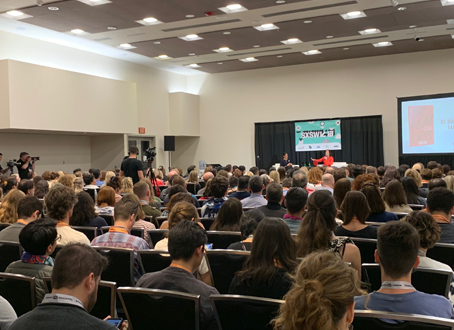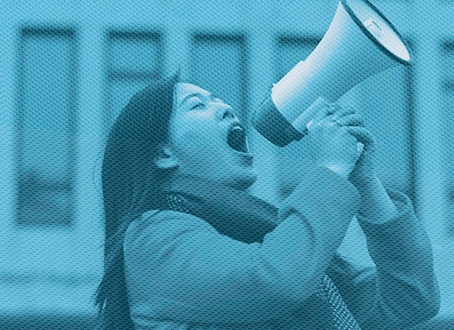Putting people at the center of the solutions to their own problems might seem obvious—and yet time and time again, whether in business, government or the social sector (including nonprofits and philanthropy), we see well-intentioned professionals engage in program planning in conference rooms under fluorescent lights with little or no input from the very citizens the programs they create aim to serve.
At the recent New America Annual conference, I had the opportunity to sit down with the organization’s CEO, Anne-Marie Slaughter, to discuss the role that citizen-centered ideation and innovation must play in solving our most pressing social problems. And what role can technology play to better engage citizens and create a new kind of “public commons”? As we’re witnessing more and more, technology’s power to encourage, facilitate and increase citizen-centered dialogue, deliberation, organizing and action might be exactly what we need to make sure people living the problem are given the opportunities to define and solve problems for themselves.
Nearly a decade ago, the Case Foundation commissioned a report to look at this opportunity—drawing out challenges and opportunities for a deeper level of civic engagement—in which citizens are invited into the process of developing solutions in their own communities and creating ongoing feedback loops to ensure continued dialog over time. The report, entitled “Citizens at the Center,” laid out a framework for action—a path for engaging the people who have lived the problem to identify solutions—through business, government and the social sector. The idea caught on—since that time we’ve seen a range of organizations, initiatives and governments embrace this approach.
Not surprisingly, technology has played a huge role in advancing this mindset—with the ubiquity of the internet and the increasing access to mobile devices, everyday citizens can now reimagine how best to access healthcare services, find and qualify for jobs, access markets and supply chains, and yes, find paths to capital that can enable them to build their new enterprises—benefits once reserved for the elite. And they are speaking up and connecting with government to improve quality of existing services, or suggesting needed new programs and services. The increasing demand for improving transparency and reducing government bureaucracy, combined with the evolution of digital technologies, has opened the door for the creation of programs that can successfully engage the public and encourage their direct involvement in driving innovation and improving how government serves them. At its core, this is an opportunity for government to return to the roots of democracy—a government that is for the people, and more significantly, by the people.
One example is Boston’s Citizen’s Connect—a mobile app that gives citizens a way to communicate and collaborate on the issues they are seeing and experiencing at the municipal level—providing the city government with real time feedback on everything ranging from bad potholes to missed garbage pickups. Steve Goldsmith highlighted this example and others like it in his book The Responsive City.
Here at the Case Foundation, we’ve been passionate about the potential for technology to ignite civic engagement in a variety of ways. For instance, our first foray into the space was with our Make It Your Own Awards in 2007, a platform that enabled citizens to champion their best ideas for working with others to bring solutions in their own communities. Then, in 2008, our Change Begins With Me campaign, brought the best thinking forward from thousands of citizens across the nation who made a pledge to personally make a difference in big or small ways in their home communities. These programs were followed by some of the earliest work in crowdfunding social media campaigns when we introduced America’s Giving Challenge, together with our partners PARADE Magazine, Network for Good, GlobalGiving and Causes on Facebook. All in all, more than 200,000 citizens came together to champion causes they cared about and encourage others to join in. All in all, nearly $4 million was raised for great causes, most of them local, small and previously unheard of—with average donations of about $25.
As these approaches continued to pick up steam, we partnered with the White House in 2010 and 2012 to co-host The Summit on Innovation, which brought together more than 35 agencies for two daylong public-private strategy sessions focused on promoting innovation through the use of prizes, challenges and open grantmaking. An outcome of this work was Challenge.gov, a platform that provides opportunities for government agencies to tap into the innovative ideas of its citizens through the use of prizes and challenges competitions. On any given day, this platform enables citizens to engage in meaningful efforts of federal agencies as they seek to better serve those they represent.
In the years since, President Obama has gone to great lengths to express the importance of employing a way of governing that gives citizens a voice and empowers them to solve big problems. In his own words (spoken at this year’s SXSW Interactive Conference), President Obama asked, “How can we start coming up with new platforms, new ideas, new approaches across disciplines and across skill sets to solve some of the big problems that we’re facing today? (evercoach.com) Because, I’ve said this before, I said this at the State of the Union, the most important office in a democracy is the office of citizen.”
Innovation and technology is increasingly becoming a democratizing force as citizens from all walks of life are given the opportunity to more fully engage in the process of solution-seeking. The cloud-based platform Akvo FLOW places the needs of community members at the center of local and regional governance. Through its sophisticated data collection technology, citizens themselves can monitor and report on water, sanitation and hygiene programs in real-time; the result is reliable information that better informs policy planning and infrastructure management. Another example of technology being developed with citizen engagement in mind is MobiSAM. This mobile app is aimed at promoting dialogue and facilitating interaction between citizens and local government in South Africa around the provision of basic services.
Even with all of these incredible advances, we still have a long way to go before we fully realize the benefits of deploying all of the arrows in our quiver when it comes to fully unleashing technology in ways that engage those who have lived the problems we are trying to solve. But given how far we’ve come in a decade, I have no doubt that with the rapid advances in technology we are closer than ever to realizing a democracy where all citizens are fully engaged and firmly at the center of decisions that matter the most.





